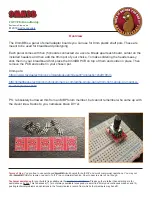
63
Try to avoid:
•
Narrow-bore or glass-frit-tipped Luggin capillaries.
•
Poorly conductive solutions, especially in Luggin capillaries.
•
Asbestos-thread and double-junction reference electrodes.
Reference electrodes often develop high impedances as they are used. Anything that can clog the isolation
frit can raise the electrode impedance. Avoid using saturated KCl-based references in perchlorate-ion
solutions.
Instrument Settings
There are several things to remember in setting up a very sensitive experiment.
•
In EIS, use the largest practical excitation.
Don’t
use a 10 mV excitation on a coated specimen
that can handle 100 mV without damage.
•
Avoid potentials where large DC currents flow. You cannot measure 1 pA of AC current on
top of 1 mA of DC current.
EIS Speed
In EIS, do not expect the Reference 600+ to measure 10
13
Ω
impedances at 1 kHz. Many of the factors
listed above limit the performance.
As a rule of thumb, the product of impedance,
Z
, times frequency,
f
, should be less than 10
9
·Hz for good
EIS measurements with a Reference 600+.
Z
·
f
< 10
9
·Hz
Ancillary Apparatus
Do not use the Reference 600+ with ancillary apparatus connected directly to any of the cell leads.
Ammeters and voltmeters, regardless of their specifications, almost always create problems when
connected to the Reference 600+ cell leads.
Floating Operation
The Reference 600+ is capable of operation with cells where one of the electrodes or a cell surface is at
earth ground. Examples of earth-grounded cells include: autoclaves, stress apparatus, pipelines, storage
tanks and battleships. The Reference 600+
’s
internal ground is allowed to float with respect to earth
ground when it works with these cells, hence the name
“
floating operation
”
.
Instrument performance can be substantially degraded when the Reference 600+ is operated in a floating
mode. The instrument specifications only apply on isolated cells with the Reference 600+ earth-ground
referenced (not floating).
Special precautions must be taken with the cell connections when the Reference 600+ must float. Make
sure that all the cell connections are isolated from earth ground. In this case, you must disconnect the
chassis-ground terminal of the Reference 600+ from earth ground.
Finally, ancillary apparatus connected to the Reference 600+ must be isolated. External voltmeters,
ammeters, FRAs, etc. must be isolated. This includes devices connected to the monitor connectors located
on the Reference 600+ rear panel.
Содержание Reference 600+
Страница 2: ...2...
Страница 6: ...4...
Страница 18: ...12 Figure 3 1 Reference 600 Potentiostat Board in Potentiostat Mode Simplified Schematic Block Diagram...
Страница 60: ...54 Figure 7 1 Fast Combination Reference Electrode SCE Platinum White Cell Lead 100 pF to 10 nF Electrolyte...
Страница 70: ...64...
Страница 76: ...Reference 600 Specifications 70...
Страница 80: ...Misc I O Connector 74...
Страница 82: ...Appendix D Auxiliary A D Input Characteristics 76...
Страница 84: ...Appendix E CE Certificate 78...
Страница 85: ...Appendix E CE Certificate 79 Certificate of Conformance...
















































